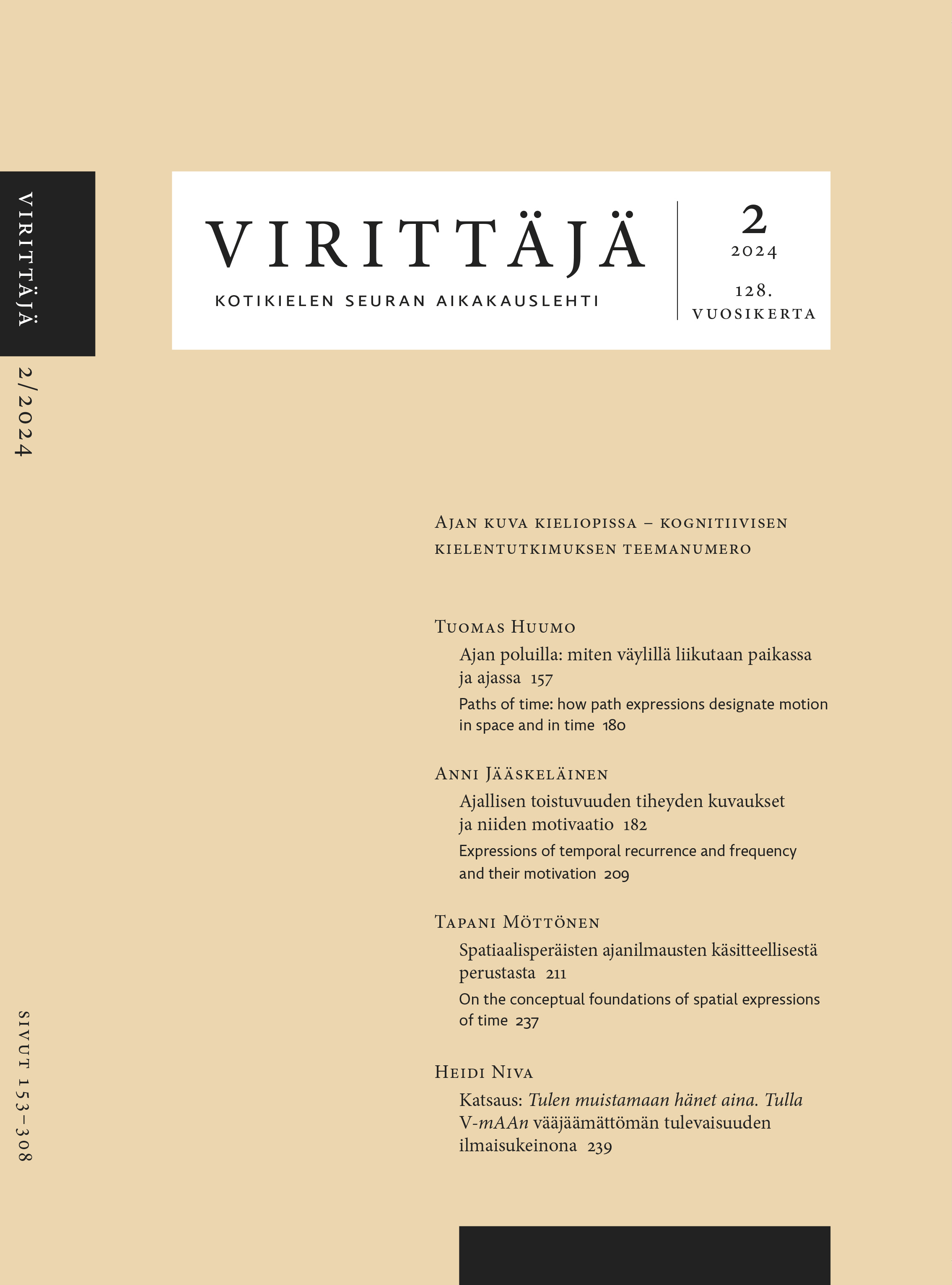Spatiaalisperäisten ajanilmausten käsitteellisestä perustasta
Abstrakti
Ajan ilmaisemista perusmerkitykseltään spatiaalisten ilmausten avulla pidetään kognitiivisessa kielentutkimuksessa yhtenä keskeisenä käsitemetaforan muotona. Spatiaalisperäisille ajanilmauksille voidaan kuitenkin ainakin joissakin tapauksessa esittää myös metonyyminen perusta: abstraktin samankaltaisuuden (kuten muutoksen tai välittömään kokemukseen ilmestymisen) sijaan ajanilmaus perustuu paikan ja ajan korrelaatioon. Tässä artikkelissa vertaillaan kognitiivisesta kielentutkimuksesta kumpuavien metafora- ja metonymiaperustaisten mallien vakuuttavuutta spatiaalisperäisten ajanilmausten kannalta. Artikkelissa tarkastellaan kyseisten selitysmallien teoreettista perustaa ja johdonmukaisuutta sekä malleja itseään analysoiden ja soveltaen niitä suomen kielen spatiaalisperäisiin ajan adpositioihin yli, läpi, vastaan, puolivälissä ja lähellä.
Käsitemetaforateoriasta paljastuu sisäistä epäjohdonmukaisuutta, eikä teoria ajanilmausten käsitteellistä perustaa kuvatessaan huomioi riittävästi aikakokemuksen kielestä riippumatonta luonnetta. Kognitiivisen kielentutkimuksen piirissä kehitetty käsitteellisen metonymian malli on perusteltu, mutta korostaa metonymian pragmaattista perustaa: käsitteellisen metonymian määritelmän mukaan spatiaalisen lähdekäsitteen tulee olla kokonaiskäsitteistyksessä jotenkin läsnä.
Dynaamisiin liiketapahtumiin liittyvien väyläadpositioiden kohdalla vaikuttaa kuitenkin uskottavalta, että niiden temporaalinen käyttö perustuu kokonaisuus–osa-metonymiaa muistuttavaan merkityssiirtymään. Tässä merkityssiirtymässä väyläskeeman liiketapahtumaa ajallisesti jäsentävä sivumerkitys etualaistuu ja adpositiosta riippuen vakiintuu jossakin määrin liiketapahtumasta itsenäiseksi ajanilmaukseksi ja joissakin tapauksissa yhdistyy spatiaalisen liikeverbin metaforiseen käyttöön. Artikkeli korostaa metonymian merkitystä vaihtoehtoisena selityksenä metaforisina pidetyille ajanilmauksille mutta havainnollistaa metaforan ja metonymian välisen vuorovaikutuksen monimutkaisuutta, johon on myös aiemassa kognitiivisessa kielentutkimuksessa kiinnitetty huomiota.
On the conceptual foundations of spatial expressions of time
The expression of time in terms of space is a promising candidate for a universal conceptual metaphor. In Cognitive Linguistics in general, and in Conceptual Metaphor Theory in particular, the expression of time by locatives, adpositions and motion verbs is typically explained by a metaphoric mapping between two domains. The approach is justified by the experiential correlation between time and space, and by cognitive economy. The relatively well-structured conceptual domain of space lends its structure to space, which itself is perceptually and conceptually less tangible. In so doing, the spatial metaphor is in some cases even posited as a conceptual precursor of some aspects of time as a conceptual and perceptual domain.
The general weakness of CMT as an account of spatially grounded expressions of time is that it over-emphasises the role of space in the conceptualisation and experience of time. Developmental and ethological evidence shows unambiguously that the experience and conceptualisation of time precedes its linguistic (and metaphorical) expression. Further, temporality can be plausibly associated with the basic structure of consciousness. Experiential semantics of time should therefore explore metonymy as a potential source of space-time mappings. At least for dynamic conceptualisations of space, temporality can be plausibly posited as a secondary semantic component, which is then contextually foregrounded in suitable communicative contexts.
This theoretical study assesses the relative plausibility of CMT and conceptual metonymy as a basis for the explanation of spatial expressions of time. CMT and conceptual metonymy are assessed in terms of their theoretical coherence vis-à-vis a) the psychology of time perception and b) the usage-based grounding of Cognitive Linguistics. Theoretical treatment of the two approaches is fleshed out in an analysis of the Finnish spatial adpositions vastaan (‘against’), läpi (‘through’) and yli (‘over’). The temporal use of these adpositions is plausibly described in terms of internal semantic adjustments, i.e. the foregrounding of the pre-existing temporal elements of these expressions. Such internal adjustment seems to be dependent on a dynamic semantic frame. In other words, while the shift itself resembles a whole-for-part metonymy, it needs to be supported by a wider motion-based conceptualisation. However, the existence of the independent temporal use of some spatial adpositions demonstrates that the dynamicity inherent to the adpositions themselves may suffice as a basis for space-time mapping.






